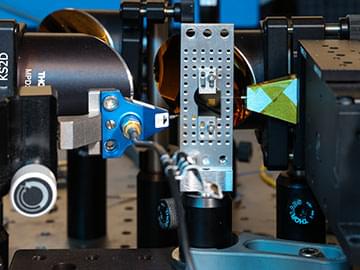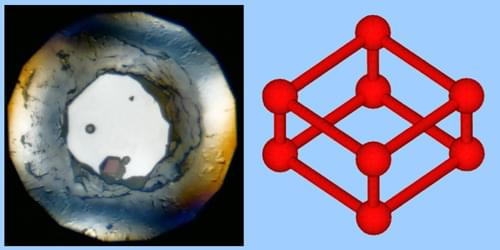Humans are one step closer to traveling at faster-than-light speeds.
Get the latest international news and world events from around the world.


Manipulating Ferroelectric Topological Polar Structures with Twisted Light
We demonstrate dynamic control of ferroelectric order in quasi-2D CsBiNb2O7 using twisted ultraviolet light carrying orbital angular momentum. Our approach harnesses non-resonant multiphoton absorption and induced strain to modulate topological of ferroelectric polarization textures. In-situ X-ray coherent imaging and Raman spectroscopy reveal reversible, nanoscale polarization transitions, enabling efficient stabilization of topological solitons and paving the way for novel optoelectronic devices.

Ripples of the future: Rice researchers unlock powerful form of quantum interference
Just as overlapping ripples on a pond can amplify or cancel each other out, waves of many kinds — including light, sound and atomic vibrations — can interfere with one another. At the quantum level, this kind of interference powers high-precision sensors and could be harnessed for quantum computing.
In a new study published in Science Advances, researchers at Rice University and collaborators have demonstrated a strong form of interference between phonons — the vibrations in a material’s structure that constitute the tiniest units, or quanta, of heat or sound in that system. The phenomenon where two phonons with different frequency distributions interfere with each other, known as Fano resonance, was two orders of magnitude greater than any previously reported.
“While this phenomenon is well-studied for particles like electrons and photons, interference between phonons has been much less explored,” said Kunyan Zhang, a former postdoctoral researcher at Rice and first author on the study. “That is a missed opportunity, since phonons can maintain their wave behavior for a long time, making them promising for stable, high-performance devices.”
Rice researchers have demonstrated a form of quantum interference two orders of magnitude greater than any previously reported.


AI model uses glucose spikes to reveal hidden diabetes risk before symptoms appear
Spread the love 19 11 To diagnose either type 2 diabetes or pre-diabetes, clinicians typically rely on a lab value known as HbA1c. This test captures a person’s average blood glucose levels over the previous few months. But HbA1c cannot predict who is at highest risk of progressing from healthy to prediabetic, or from prediabetic to full-blown diabetes.
5 Weird Alien Tech Sci-Fi You Need to Read
In this video, I’m counting down 5 Weird Alien Tech Sci-Fi You Need to Read—plus a few honourable mentions—for fans of mind-bending, physics-breaking, utterly baffling extraterrestrial inventions.
🚀My new sci-fi book, Tao Solandis, is finally available for pre-order.📖 Links to all the ways you can pre-order — https://linktr.ee/scifiodyssey.
Check out these early Tao Solandis reviews:
Startling Deathbed Visions & What People Get Wrong About Human Consciousness
A Death Doula’s Guide to Consciousness After Death with Mayim & Jonathan.
In this powerful and emotional Mayim Bialik’s Breakdown episode, licensed end-of-life counselor and death doula Dr. Martha Jo Atkins explores consciousness after death and what truly happens when we die. Drawing on decades of guiding people through their final moments, she reveals the spiritual, biological, emotional, and psychological changes that occur when consciousness leaves the body—offering profound insights into life after death and the mysteries of the dying process.
You’ll hear jaw-dropping stories of deathbed visions, including dream shifts, visits from deceased loved ones, and shared death experiences where relatives actually feel what the dying person is experiencing. Dr. Atkins shares what she’s witnessed that made her believe in the afterlife, what understanding death can teach us about living, and her own supernatural encounters—from speaking to deceased loved ones in dreams to eerie hospice hauntings.
Dr. Atkins also breaks down:
- Why we’re so afraid to talk about death—and how doing so makes us more human.
- How sensory perception shifts as people begin to let go, and the signs that death is near.
- The difference between a natural death and dying before your time—and what that means for the soul’s journey.
- Could Ketamine-Assisted Psychotherapy help us process grief in healthier ways?
- Why presence matters most in a loved one’s final days.
- How our treatment of elders reflects our values as a society, and why end-of-life care matters deeply.
Plus, Mayim opens up about the raw, painful, yet beautiful experience of caregiving for her father in his final days.
Whether you’re grieving, caregiving, or simply seeking answers to what happens when we die, or wondering what leaves the body when we die, this episode offers rare wisdom and comfort for life’s most inevitable transition.

